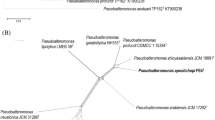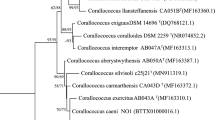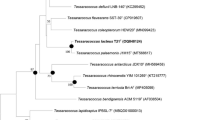Abstract
A Gram-reaction-negative, facultatively aerobic, motile, non-spore-forming, rod-shaped, and denitrifying bacterium, designated dN18-1T, was isolated from activated sludge, Republic of Korea. This bacterium was investigated via a polyphasic approach to reveal its taxonomic position. Phylogenetic analysis based on 16S rRNA gene sequence indicated that strain dN18-1T belongs to the genus Paludibacterium and is most closely related to P. purpuratum KCTC 42852T (96.2% sequence similarity), P. yongneupense KACC 11601T (96.1%), and P. paludis BCRC 80514T (95.2%). The average nucleotide identity values and digital DNA-DNA hybridization values calculated between strain dN18-1T and the closely related strains were 72.5–73.1% and 19.0–19.6%. The genome comprises of 3,347,996 bp with a G + C content of 57.3 mol%. Strain dN18-1T possesses ubiquinone Q-8 as a predominant respiratory quinone, and summed feature 3 (C16:1 ω6c and/or C16:1 ω7c), summed feature 8 (C18:1 ω6c/C18:1 ω7c), C16:0 and C12:0, as its major fatty acids (>5%). The polar lipids consisted of diphosphatidylglycerol, phosphatidylglycerol, phosphatidylethanolamine, two unidentified phospholipids and four unidentified aminophospholipids. The results of ANI calculation, digital DNA-DNA hybridization, physiological and biochemical tests allowed phenotypic differentiation of strain dN18-1T from rephrase other genus Paludibacterium species with validly published names. Therefore, this isolate represents a novel species, for which the name Paludibacterium denitrificans sp. nov. (type strain dN18-1T = KACC 19537T = CGMCC 1.16961T) is proposed.

Similar content being viewed by others
References
Siddiqi MZ, Sok W, Choi G, Kim SY, Wee JH, Im WT (2020) Simplicispira hankyongi sp. nov., a novel denitrifying bacterium isolated from sludge. Antonie Van Leeuwenhoek 113:331–338. https://doi.org/10.1007/s10482-019-01341-0
Kwon SW, Kim BY, Kim WG, Yoo SH, Son JA (2008) Paludibacterium yongneupense gen. nov., sp. nov., isolated from a wetland, Yongneup, in Korea. Int J Syst Evol Microbiol 58:109–194. https://doi.org/10.1099/ijs.0.64831-0
Sheu SY, Chen ZH, Young CC, Chen WM (2014) Paludibacterium paludis sp. nov., isolated from a marsh. Int J Syst Evol Microbiol 64:2497–2502. https://doi.org/10.1099/ijs.0.060954-0
Kang H, Kim H, Joung Y, Kim KJ, Joh K (2016) Paludibacterium purpuratum sp. nov., isolated from wetland soil. Int J Syst Evol Microbiol 66:2711–2716. https://doi.org/10.1099/ijsem.0.001112
Lane DJ (1991) 16S/23S rRNA sequencing. In: Stackebrandt E, Goodfellow M (eds) Nucleic acid techniques in bacterial systematics. Wiley, Chichester, pp 115–175
Weisburg WG, Barns SM, Pelletier DA, Lane DJ (1991) 16S ribosomal DNA amplification for phylogenetic study. J Bacteriol 173:697–703. https://doi.org/10.1128/jb.173.2.697-703.1991
Yoon SH, Ha SM, Kwon S, Lim J, Kim Y et al (2017) Introducing EzBioCloud: a taxonomically united database of 16S rRNA and whole genome assemblies. Int J Syst Evol Microbiol 67:1613–1617. https://doi.org/10.1099/ijsem.0.001755
Thompson JD, Gibson TJ, Plewniak F, Jeanmougin F, Higgins DG (1997) The CLUSTAL_X windows interface: flexible strategies for multiple sequence alignment aided by quality analysis tools. Nucleic Acids Res 25:4876–4882. https://doi.org/10.1093/nar/25.24.4876
Hall TA (1999) BioEdit: a user-friendly biological sequence alignment editor and analysis program for Windows 95/98/NT. Nucleic Acids Symp Ser 41:95–98
Kimura M (1980) A simple method for estimating evolutionary rates of base substitutions through comparative studies of nucleotide sequences. J Mol Evol 16:111–120. https://doi.org/10.1007/BF01731581
Saitou N, Nei M (1987) The neighbor-joining method: a new method for reconstructing phylogenetic trees. Mol Biol Evol 4:406–425. https://doi.org/10.1093/oxfordjournals.molbev.a040454
Fitch WM (1971) Toward defining the course of evolution: minimum change for a specific tree topology. Syst Zool 20:406–416. https://doi.org/10.2307/2412116
Kumar S, Stecher G, Tamura K (2016) MEGA7: molecular evolutionary genetics analysis version 7.0 for bigger datasets. Mol Biol Evol 33:1870–1874. https://doi.org/10.1093/molbev/msw054
Felsenstein J (1985) Confidence limits on phylogenies: an approach using the bootstrap. Evolution 39:783–791. https://doi.org/10.1111/j.1558-5646.1985.tb00420.x
Tatusova T, DiCuccio M, Badretdin A, Chetvernin V, Nawrocki EP et al (2016) NCBI prokaryotic genome annotation pipeline. Nucleic Acids Res 44:6614–6624. https://doi.org/10.1093/nar/gkw569
Moore DD, Dowhan D (1995) Preparation and analysis of DNA. Curr Protoc Mol Biol. https://doi.org/10.1002/0471142727.mb0200s98
Mesbah M, Premachandran U, Whitman WB (1989) Precise measurement of the G+C content of deoxyribonucleic acid by high-performance liquid chromatography. Int J Syst Bacteriol 39:159–167. https://doi.org/10.1099/00207713-39-2-159
Yoon SH, Ha SM, Lim J, Kwon S, Chun J (2017) A largescale evaluation of algorithms to calculate average nucleotide identity. Antonie Van Leeuwenhoek 110:281–1286. https://doi.org/10.1007/s10482-017-0844-4
Li FN, Liao SL, Liu SW, ** T, Sun CH (2019) Aeromicrobium endophyticum sp. nov., an endophytic actinobacterium isolated from reed (Phragmites australis). J Microbiol 57:725–731. https://doi.org/10.1007/s12275-019-8705-7
Krebs JE, Gale AN, Sontag TC, Keyser VK, Peluso EM, Newman JD (2013) A web-based method to calculate average amino acid identity (AAI) between prokaryotic genomes. Biotechniques
Buck JD (1982) Nonstaining (KOH) method for determination of Gram reactions of marine bacteria. Appl Environ Microbiol 44:992–993. https://doi.org/10.1128/aem.44.4.992-993.1982
Weon HY, Kim BY, Joa JH, Son JA, Song MH et al (2008) Methylobacterium iners sp. nov. and Methylobacterium aerolatum sp. nov., isolated from air samples in Korea. Int J Syst Evol Microbiol 58:93–96. https://doi.org/10.1099/ijs.0.65047-0
Cappuccino JG, Sherman N (2002) Microbiology: a laboratory manual, 6th edn. Pearson Education Inc., San Francisco, pp 15–224
Atlas RM (1993) Handbook of microbiological media. CRC Press, Boca Raton
Cowan ST, Steel KJ (1974) Manual for the identification of medical bacteria. Cambridge University Press, Cambridge
Breznak JA, Costilow RN (2007) Physicochemical factors in growth. In methods for general and molecular microbiology. Am Soc Microbiol 3:309–329
Hiraishi A, Ueda Y, Ishihara J, Mori T (1996) Comparative lipoquinone analysis of influent sewage and activated sludge by high-performance liquid chromatography and photodiode array detection. J Gen Appl Microbiol 42:457–469. https://doi.org/10.2323/jgam.42.457
Sasser M (1990) Identification of bacteria by gas chromatography of cellular fatty acids. MIDI technical note 101. MIDI Inc., Newark
Minnikin DE, O’Donnell AG, Goodfellow M, Alderson G, Athalye M et al (1984) An integrated procedure for the extraction of bacterial isoprenoid quinones and polar lipids. J Microbiol Methods 2:233–241. https://doi.org/10.1016/0167-7012(84)90018-6
Alanjary M, Steinke K, Ziemert N (2019) AutoMLST: an automated web server for generating multi-locus species trees highlighting natural product potential. Nucleic Acids Res 47:276–282. https://doi.org/10.1093/nar/gkz282
Kim M, Oh HS, Park SC, Chun J (2014) Towards a taxonomic coherence between average nucleotide identity and 16S rRNA gene sequence similarity for species demarcation of prokaryotes. Int J Syst Evol Microbiol 64:346–351. https://doi.org/10.1099/ijs.0.059774-0
Wayne LG, Brenner DJ, Colwell RR, Grimont PAD, Kandler O et al (1987) Report of the ad hoc committee on reconciliation of approaches to bacterial systematics. Int J Syst Evol Microbiol 37:463–464. https://doi.org/10.1099/00207713-37-4-463
Luo C, Rodriguez-R LM, Konstantinidis KT (2014) MyTaxa: an advanced taxonomic classifier for genomic and metagenomic sequences. Nucleic Acid Res 42:73–84. https://doi.org/10.1093/nar/gku169
Funding
This research was supported by the project on survey and excavation of Korean indigenous species of the National Institute of Biological Resources (NIBR) and by a grant from the Korea Research Institute of Bioscience & Biotechnology (KRIBB) Research Initiative Program (KGM5232113).
Author information
Authors and Affiliations
Contributions
Conceived and designed the experiments: JEL, GMC (2nd author), YJL (3rd author), WTI. Performed the experiments: JEL GMC. Analyzed the data: JEL GMC YJL SML WTI. Wrote the paper: JEL WTI.
Corresponding author
Ethics declarations
Conflict of interest
This article does not contain any studies with human participants or animals performed by any of the authors. Moreover, all authors read and approved the final manuscript. All the authors declare that they have no direct or indirect conflict of interest.
Ethical Approval
It is the original work of the author. The work described has not been submitted elsewhere for publication, in whole or in part, and all authors listed carry out the data analysis and manuscript writing.
Additional information
Publisher's Note
Springer Nature remains neutral with regard to jurisdictional claims in published maps and institutional affiliations.
Supplementary Information
Below is the link to the electronic supplementary material.
284_2022_2855_MOESM2_ESM.pptx
Supplementary file2 (PPTX 52 kb) Fig. S1 Phylogenetic tree (constructed with maximum-likelihood method) showing the relationships of strain dN18-1T with other related species of the genus Paludibacterium. Bootstrap values (expressed as percentages of 1000 replications) greater than 50% are shown at the branch points
284_2022_2855_MOESM3_ESM.pptx
Supplementary file3 (PPTX 53 kb) Fig. S2 The phylogenetic tree was constructed from a comparative analysis of whole-genome sequences showing the relationships of strain dN18-1T with related species of the family Chromobacteriaceae. This tree was constructed via Automated Multi-Locus Species Tree online web server. Bar represents 0.02 substitutions per nucleotide position
284_2022_2855_MOESM5_ESM.pptx
Supplementary file5 (PPTX 747 kb) Fig. S4 Transmission electron microscopy micrograph showing morphology of strain dN18-1T. Cells were grown on R2A agar at 30 °C for 3 days. Bar, 1 μm
284_2022_2855_MOESM6_ESM.pptx
Supplementary file6 (PPTX 267 kb) Fig. S5 Two-dimensional thin-layer chromatography of the total polar lipids of strain dN18-1T. Chloroform-methanol-water (65:25:4, by vol.) was used in the first direction, followed by chloroform-acetic acid-methanol-water (40:7.5:6:2, by vol.) in the second direction. The following spray reagents were used for detection: (a) 5% ethanoic molybdophosphoric acid (for total lipids); (b) molybdenum blue (Sigma) (for phosphorus-containing polar lipids); (c) 2% ninhydrin (for amino lipids). PE, phosphatidylethanolamine; PG, phosphatidylglycerol; DPG, diphosphatidylglycerol; PL, unidentified phospholipid; APL, aminophospholipid
Rights and permissions
About this article
Cite this article
Lee, J.E., Choi, GM., Lee, YJ. et al. Paludibacterium denitrificans sp. nov., a Novel Denitrifying Bacterium Isolated from Activated Sludge. Curr Microbiol 79, 158 (2022). https://doi.org/10.1007/s00284-022-02855-z
Received:
Accepted:
Published:
DOI: https://doi.org/10.1007/s00284-022-02855-z




